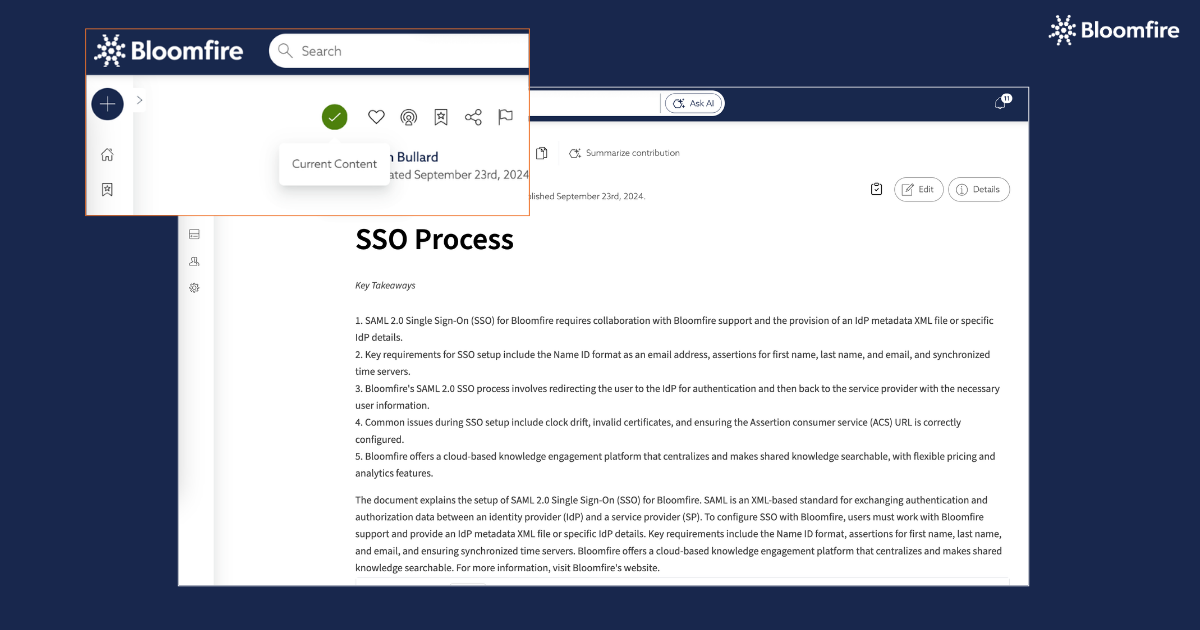9 Common Knowledge Management Challenges (and Their Solutions)

Choosing to implement knowledge management (KM) can be an exciting time for you and your team. After all, a KM solution streamlines knowledge acquisition, organization, updating, and sharing across the company–a top feat for business operations.
However, introducing a new approach and technology to knowledge management is not without its challenges–from getting your senior leadership and employees on board to overwhelming information, access security, establishing trustworthiness, and ensuring scalability. To dive deeper into these obstacles, we outline nine of the most common knowledge management challenges and what you can do to overcome them.
1. Getting Employee Buy-In
Employees are notoriously reluctant to accept change. In fact, it has been industry insight that an estimated 70% of change programs fail mainly due to employee resistance.
Introducing a new KM system can potentially overwhelm your teams, pushing them to revert to “the old way.” Plus, once your personnel have a particular way of completing their work, they often don’t want to veer from that process.
Solution: Boost change awareness
Initiating a new system in your company requires careful pre-implementation planning, including employee resistance management. To get them on board with using the new KM platform, begin by informing the workforce of the reason for this action. Keep in mind that lack of awareness about the change is one of the key factors in employee resistance.
Additionally, employees must understand how it will benefit them (e.g., by helping them find information more quickly or increasing the visibility and impact of their work). In doing so, be proactive in establishing and protecting trust between your organization and the personnel.
2. Securing Senior Leadership Buy-In
A culture of knowledge-sharing and engagement starts from the top down. However, senior leaders can also be slow to adopt new technology, depending on their comfort level and prioritization regarding using the system.
Some executives may assume that knowledge management doesn’t always directly fit into their day-to-day responsibilities and roles. This is particularly true if they tend to focus more on big-picture strategy items and deprioritize or re-allocate certain administrative tasks.
Unfortunately, when employees notice that leaders and managers aren’t using the technology, they may follow suit, slowing the overall technology adoption. As a result, it breeds other challenges of KM systems implementation that can lead to discontinuation.
Solution: Model technology use
To convey the importance of KM and reduce employee hesitancy, persuade the senior leaders to publicly encourage knowledge sharing and demonstrate their use of the KM system. Make it a part of your employee resistance strategy and allow them to understand the implications of actively rejecting the new system.
Consider selecting a champion from the senior leadership team who will speak about the value of knowledge management and convey the importance of adopting the new system. This leader can also be the face of regular video updates or other publishing materials in the KM platform, showing how the platform is the organization’s go-to place for the latest trusted information.
3. Technology Fatigue
The rapid evolution of business technologies means that companies will likely update or switch to new tools and software regularly until the most suitable system is chosen. While this trial-and-error tactic can increase business performance in the long run, it can also lead to employees experiencing technology fatigue.
As a result, many employees find it difficult to focus on their job duties, hindering efficient work completion when they’re continually asked to update current technology and adopt new ones. Burnout becomes inevitable, which adds significantly to employee resistance against change.
Plus, your workforce can be skeptical about using new KM technology if they’ve seen digital transformation efforts fail in the past. After all, why invest time and effort into learning new tools if the company will eventually revert to the original processes?
Solution: Implement a change management strategy
Prevent technology fatigue by carefully choosing the most suitable KM platform for your team early on. This minimizes frequent switching to new options. Consider user-friendliness as one of your selection criteria. An easy-to-use knowledge management platform will require fewer IT resources and updates and take less time for end users to learn.
If it comes to a point where you must get a new KM solution, establish a change management strategy. The team responsible for the implementation should prepare a short elevator pitch for the work teams that answers the following questions:
- What problems will the new knowledge management technology solve?
- What specific needs will the platform meet for the end users?
- What will the organization look like in a year or two, thanks to the change?
4. Information Overload
Further into implementing your new KM technology, you may face a new challenge: navigating your platform’s ever-growing wealth of knowledge.
By design, you want to accumulate that knowledge. However, the more content stored in your platform, the more challenging it can become for employees to quickly find the information they need.
It gets even worse if your platform uses a folder-based system like Google Drive or SharePoint as a knowledge-sharing solution. If your personnel don’t understand the organizational taxonomy, they will likely struggle to access the correct information—and may even find and use outdated resources.
Solution: Opt for a platform with navigational support
To avoid confusion when dealing with information overload, employees must be able to intuitively navigate to the content most relevant to them. Your platform should be equipped with a powerful search engine that indexes every word in every file—even those spoken within audio and video files–so employees can find what they’re looking for, even if they don’t know the exact file name or title.
Giving users multiple routes to find a particular resource is also helpful. For example, employees may look for information via a keyword search or by using category filters to narrow down the available results until they find what they need.
Did You Know?
Bloomfire provides an AI-powered enterprise search that increases the speed and accuracy of content access, ensuring the reference that matters most stays front and center.
Learn More About AI-Powered Enterprise Search
5. Documenting Knowledge
Getting your team to contribute to knowledge documentation is one of the recurring challenges of building knowledge management systems. Uploading existing content assets to your KM platform is relatively simple, but what about the know-how in employees’ heads?
Tacit knowledge, or the type that comes from personal experience, is highly essential and must be preserved as it can boost productivity and help new hires get up to speed faster. Its practicality provides a clear direction to ideal steps and information employees can prioritize. However, this requires conscious extraction through writing or verbalization–a requirement that is often a barrier to tacit knowledge retention.
Your personnel may resist documenting their learning if they feel it will be too time-consuming and take them away from other responsibilities. As a result, you could be missing out on a wealth of valuable information that can be passed on to new employees.
Solution: Streamline documentation and add it as a KPI
Encourage employees to share what they know by making the documentation process easy. Develop templates for common content types so they do not start from scratch. Then, allow them to choose the documentation format they are most comfortable with. For example, some employees might prefer recording a how-to video instead of writing a step-by-step guide.
Team leaders should also consider including knowledge documentation in their team members’ job descriptions. Establishing a clear key performance indicator (KPI) around documentation allows the employees to prioritize the task, making it a work responsibility rather than an afterthought.
6. Ensuring Content Trustworthiness
An important aspect of maintaining a KM system is ensuring its information is up-to-date and accurate. Similarly, it’s also one of the must-tracked challenges of implementing knowledge management systems. If time-sensitive content isn’t regularly updated or archived, employees may access and use outdated resources.
This drawback can be especially harmful if your personnel share inaccurate knowledge with customers and stakeholders. Once that happens, employees may lose trust in the system and hesitate to use it regularly.
Solution: Choose a KM Platform with content freshness tools
Employees must feel confident in the information within the knowledge management platform. To build this confidence, your company should look for KM solutions that allow contributors to automatically unpublish or schedule reviews when content expires.
In Bloomfire, for example, you can choose how long you want the content to be listed as current on the platform. It will display a “Current Content” badge on up-to-date posts. This helps employees know that they are accessing trusted and refreshed resources.

7. Guaranteeing Knowledge Security
Information and data related to your business operations, work execution, and critical insights hold tremendous value and should be protected at all costs. When implementing a KM solution, a probable concern for leaders and team members is the level of security to ward off cyber-attacks and data breaches. It can even breed misconceptions about the risks of knowledge management that may hold you back from taking the system’s full benefits.
Internally, some departments may become wary of sharing data or information across various teams, particularly if they have been used to knowledge silos due to safe-keeping initiatives. Access authorization may also be questioned along the way.
Solution: Review security measures and formulate policies
As with the other knowledge management challenges above, a key step to addressing this barrier is a KM solution with security and privacy features and a proven commitment to data protection. Ask questions about how the platform reinforces safeguards, such as two-factor authentication, data encryption, permission-based access, and data backup.
On top of that, comprehensive security policies should be developed that detail specific restrictions and compliance protocols regarding knowledge usage and access authorization. Reassure your teams of these measures and let them understand the value of knowledge as a company asset, allowing them to be more accountable for KM protection.
8. Assessing KM Solution ROI
A KM platform is an investment not only for keeping information assets intact but also for supporting business and workforce productivity in the best possible way. When a company leverages KM software, these advantages become clear.
However, to underscore the platform’s worth, clear business metrics may be necessary to review its return on investment (ROI)–a critical aspect of championing its long-term value. Otherwise, support for its continuous implementation or upgrades may dwindle among stakeholders.
Solution: Establish knowledge management goals
Calculating the ROI metrics can be challenging because KM’s benefits are primarily intangible. This is why it’s important to outline your goals relative to knowledge management from the beginning. These goals can become your basis for coming up with sensible metrics that match or relate to the ROI evaluation of the system.
For example, part of your goal could be increasing resolution efficiency during a sales call by making playbooks and canned query answers easily accessible on the platform through direct search. In this case, you can consider metrics such as sales call quality and conversion rate relative to increased technology support.
9. Scalability Constraints
Imagine using a KM solution for a long period of time, only to be stalled when your business expands. You may have established new departments, business locations, and teams, but your KM system can’t keep up.
If the platform you’re using doesn’t offer scalable plans or tailored options, the added knowledge volume and the need to untangle the complexity of the expansion can impact your workforce efficiency. This is especially true if the platform usage is engraved in your personnel’s day-to-day functions.
Solution: Check for flexibility when choosing a KM solution
When you’re screening for the most suitable KMt system for your team, check for scalable options for when your business needs change. Upgrading or customization is a better approach than switching to a new platform, as you avoid the challenges of knowledge management implementation listed above.
Say you started with Bloomfire’s Department-Wide Access. Your company operations have drastically grown in a short time span, and you’re now establishing new teams and workflows. It might be beneficial to shift to the next tier or a more customized KM platform tailored to your organization’s current demands.
Overcoming Knowledge Management Challenges
Change can be hard—but when it comes to implementing a KM platform, the benefits outweigh the challenges. In addition, most of these barriers can be eliminated by choosing the right platform and clearly communicating its benefits. Like your other investments, begin carefully planning, anticipate the potential roadblocks, and develop a game plan.
This post was most recently updated and expanded in November 2024.
Get Guidance From Our Experts!
Schedule a consultation for knowledge management solutions tailored to your needs.
Book a Schedule

Enterprise AI Search: Definition, Benefits, and Evolution

The Benefit of Company-Wide Knowledge Management in 2026

Are You Making These Common Knowledge Sharing Mistakes?

Estimate the Value of Your Knowledge Assets
Use this calculator to see how enterprise intelligence can impact your bottom line. Choose areas of focus, and see tailored calculations that will give you a tangible ROI.

Take a self guided Tour
See Bloomfire in action across several potential configurations. Imagine the potential of your team when they stop searching and start finding critical knowledge.